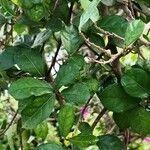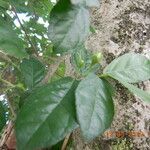Trees or shrubs; monoecious or dioecious. Bark dark gray, scabrous. Branchlets with short stiff hairs; lenticels conspicuous when young. Stipules small, caducous. Leaves shortly petiolate or sessile; leaf blade elliptic-obovate to elliptic, 2.5-6 × 2-3.5 cm, leathery, scabrous, base obtuse to ± cordate, margin entire or irregularly crenate, apex blunt to shortly acuminate; secondary veins 4-7 on each side of midvein. Bisexual inflorescences capitate with 1 central sessile female flower surrounded by male flowers. Male inflorescences solitary or paired, capitate; peduncle 8-10 mm, pubescent; bracts few, at inflorescence base, none between flowers, small, narrowly elliptic; bracteoles 2, at base of calyx, larger than bracts. Female inflorescences pedunculate; bracts 1 or 2, at base of peduncle, minute; bracteoles at base of calyx. Male flowers: subsessile; pistillode conic to cylindric, apically tuberculate. Female flowers: calyx lobes pubescent; ovary globose; style apically branched, 6-12 mm in fruit. Drupes yellow, globose, ca. 6 mm in diam., indehiscent, enclosed by enlarged calyx lobes when immature, without a fleshy base. Fl. Feb-Apr, fr. May-Jun.
A tree up to 15 m high and 30 cm across the trunk. It is a scraggly tree with stiff branches. The bark is smooth and grey. The small branches are hairy and interwoven. The leaves are alternate and 4 to 12 cm long by 1-4 cm wide. They have a narrow base and a pointed tip. There are narrow teeth along the edge. They are somewhat rough textured. The flowers are yellow or green and small. Male flowers are in round masses and female flowers occur singly. The fruit are oval and pale yellow. They are red when mature. They are 8 to 10 mm long and fleshy with seeds 5 to 6 mm long. The fruit are sweet and edible.




